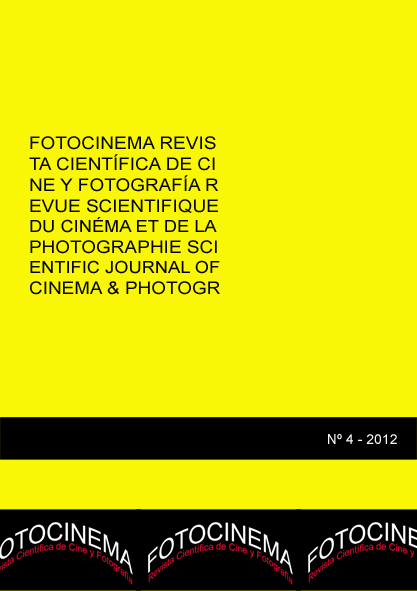La Escuela de Du?sserdolf y el cine de Wim Wenders
DOI:
https://doi.org/10.24310/Fotocinema.2012.v0i4.5880Abstract
El protagonismo de la imagen fotográfica en el cine de Wim Wenders, ya ha sido largamente estudiado, permitiéndonos un análisis aislado de la fotografía en su cine, que responda a la pregunta: qué estilo fotográfico e influencias se pueden hallar en la filmografía de Wenders. A partir de su propia auto-definición como cineasta y fotógrafo, compararemos sus imágenes, revisando las génesis y nexos que comparten, con el movimiento fotográfico de la Escuela de Düsserdolf que se construye en la misma Alemania de Wenders.
Los mentores de esta Nueva Fotografía, son el matrimonio Becher: Bern y Hilla Becher iniciado en 1959, en Düsserdolf, y que junto a sus discípulos: Andreas Gursky, Candida Höfer, Thomas Struth o Thomas Ruff, colocarán a la fotografía en la primera línea del arte actual. Este hecho a un autor multidisciplinar como Wenders, no le pasará inadvertido, sino todo lo contrario; absorberá el nuevo discurso que propone esta Escuela, para exponerlo en sus tomas, revelando así en su cine una exégesis de esta nueva propuesta fotográfica en dialogo con el lenguaje cinematográfico. Todos ellos contribuirán a consolidar la imagen como arte, erigiendo al paisaje como protagonista principal.
Palabras clave: Escuela de Fotografía de Düsserdolf, Wim Wenders, Bern y Hilla Becher, Andreas Gursky, Candida Höffer, Thomas Struth, Nueva Objetividad alemana.
Keywords: Photographic School of Dusserdolf, Wim Wenders, Bern and Hilla Becher, Andreas Gursky, Candida Höfer, Thomas Struht, German New Objectivity.
Downloads
Metrics
Publication Facts
Reviewer profiles N/A
Author statements
Indexed in
-
—
- Academic society
- N/A
- Publisher
- Universidad de Málaga
Downloads
Published
How to Cite
Issue
Section
License
All contents published in Fotocinema Revista científica de cine y fotografía are protected under the Creative Commons Attribution-NonCommercial-ShareAlike 4.0 International (CC BY-NC-SA 4.0) license. All about this license is available in the following link: <http://creativecommons.org/licenses/by-nc-sa/4.0>
Users can copy, use, redistribute, share and exhibit publicly as long as:
- The original source and authorship of the material are cited (Journal, Publisher and URL of the work).
- It is not used for comercial purposes.
- The existence of the license and its especifications are mentioned.
There are two sets of authors’ rights: moral and property rights. Moral rights are perpetual prerogatives, unrenounceable, not-transferable, unalienable, imprescriptible and inembargable. According to authors’ rights legislation, Fotocinema. Revista científica de cine y fotografía recognizes and respects authors moral rights, as well as the ownership of property rights, which will be transferred to University of Malaga in open access. The property rights are referred to the benefits that are gained by the use or the dissemination of works. Fotocinema. Revista científica de cine y fotografía is published in an open access form and it is exclusively licenced by any means for doing or authorising distribution, dissemination, reproduction, , adaptation, translation or arrangement of works.
Authors are responsable for obtaining the necessary permission to use copyrighted images.














13.png)



